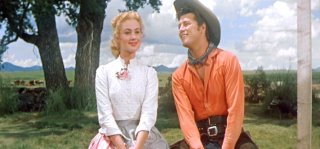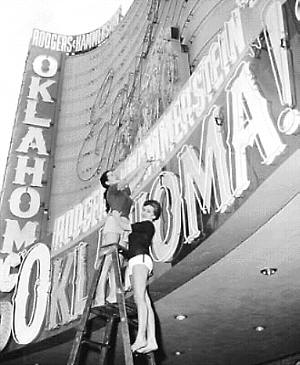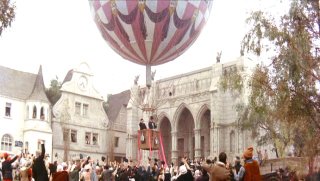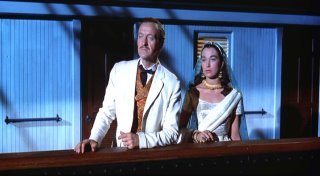 Mike Todd’s
Mike Todd’s professional triumphs
and personal tragedies
The greatest initial obstacle that needed to be overcome by Mike Todd was to gain widespread acceptance for Todd A-O from the industry at large. Unlike Darryl F. Zanuck who had launched Cinemascope with the complicity and backing of an entire studio, Todd A-O was a technical process without a product to sell it. Undaunted, Todd approached playwrights Richard Rodgers and Oscar Hammerstein II with a demonstration reel and the proposition to produce a film version of their first Broadway smash, Oklahoma! Impressed by what they saw, Rogers and Hammerstein willingly invested in the future of their film franchise with Todd and his associates. The venture secured, Todd wasted no time in hedging his bets, photographing Oklahoma! twice: once in Todd A-O and once in the more conventional Cinemascope in order to accommodate as many theatrical venues as possible.

Although the initial and exclusive engagements of Oklahoma! at Grauman’s Egyptian Theatre and New York’s Rivoli were a resounding critical success the majority of theater patrons never saw the film in Todd-AO. Instead, they were shown the CinemaScope version which was visually and cinematically inferior in almost every aspect. Despite its stunningly vibrant image, the Todd A-O version of Oklahoma! was a decidedly tempered visual experience that did not fully exploit all of the involved photographic capabilities that Todd A-O could deliver. Thus, Todd introduced both his process and Oklahoma! with a short subject; The  Miracle of Todd A-O that included among other things, breathtaking aerial photography and a roller coaster ride.
Miracle of Todd A-O that included among other things, breathtaking aerial photography and a roller coaster ride.
To further showcase Todd A-O, the master showman turned his attentions to a subject very close to his own heart: Jules Verne’s 19th century novel, Around The World In 80 Days (1956). Plagued by numerous financial and technical difficulties Todd’s Broadway stab at the property had opened and closed with minimal fanfare and zero profit.
Todd had always envisioned the Verne tale as an all-star spectacle. For the film version, he literally invented the concept of ‘the cameo’ defined by Todd as a brief and subtle bit of business performed excellently by a stellar performer. Determined to make the show as big and brassy as was then possible, Todd set about bribing, entertaining and minimally paying some of the biggest names in Hollywood and abroad to appear in his film adaptation. These included Ronald Colman, Robert Morley, Trevor Howard, Marlene Dietrich, Red Skelton, Frank Sinatra, Noel Coward, Charles Boyer, Caesar Romero, Jose Greco, Cantinflas and, in the starring role as daring and determined Professor/explorer extraordinaire Phileus Fogg, David Niven. 
Press promotion of the day, most of it tightly controlled (and perhaps ‘slightly’ exaggerated) by Todd, proclaimed that the film boasted the greatest assemblage of talent and costumes ever brought together for one production. On 140 sets built at six of the major studios, Hollywood’s Western Costume Company reportedly pillaged warehouses in London, Japan, Hong Kong and Spain – as well as their own – to make up the 74,685 modes of apparel for principal cast and extras, of which there were rumored to be more than 68,894 spread across 13 countries. Ninety animal handlers and trainers were responsible for 8,552 animals used throughout various sequences in the film.
To inaugurate the ‘experience’ of it all, Todd enlisted eminent journalist, Edward R. Murrow in a prologue that was as much Hollywood hokum as it was intended to draw comparison between the standard screen format and Todd’s impressively gigantic Todd A-O process. Despite Todd’s claim, and that of the film’s title, most of Around the World in 80 Days was shot in and around Hollywood with a second unit flown to various locations to capture establishing shots later inserted as background.
By the time Around The World in 80 Days began production it was already rumored as one of the most opulent and all-star entertainments ever filmed. However, as had been the case with Oklahoma!, the Todd A-O road show version of Around the World in 80 Days proved to have a limited release and was eventually and mostly screened in 35mm reduction prints by the general public.
However, unlike Oklahoma’s two version set up, Todd's director of photography, Lionel Linden only photographed Around the World in 80 Days once on 65 mm stock, thereafter reprinting the same version to the smaller gauge film for the lesser markets. Linden used two identical Todd-AO cameras and lenses side by side to photograph the various versions of the film; one running at 30fps in 70mm, the other at 24fps on 35mm reduction prints. In rare cases the same camera was used simply by recalibrating its speed, or, maintaining the same speed with a single camera setup. This last remedy was only used for economy’s sake and in scenes where no dialog was involved since the discrepancy between 30 and 24fps would have resulted in a re-syncing nightmare.
Throughout his fledging career as film producer, Todd had remained financially strapped; cutting corners wherever he could while maintaining a significant amount of showman-like integrity for the initial premiere engagement of his films. The curiosity surrounding Michael Todd is that, as an individual, financial success seems to have paled in comparison to his manic and ever-changeable zeal for putting on a good show. Today, Around The World In 80 Days appears as little more than overblown travelogue; a far cry from the near unanimous accolades and Oscar it received as Best Picture in 1956. The discrepancy in its reception – then and now - seems to be predicated on the fact that no one today is likely to have witnessed the film in its 70mm splendor. Minus Todd A-O 30fps razor sharp image and enveloping presentation, the film remains something of an elegant disappointment, just as 35mm reduction prints of How The West Was Won pale to the mammoth three camera projection used during that film’s first Cinerama road show. As press promotion for Around The World In 80 Days mounted, Todd, who had seemingly grown tired of the efforts invested thus far, divested his own interests in Todd-AO. Although he had already secured Rodgers and Hammerstein’s South Pacific as the next big project, those details were shortly thereafter inherited by Magna Film Corporation, American Optical and the film’s distribution apparatus, 20th Century Fox. Having abandoned their home grown Cinemascope 55, Fox purchased Todd A-O outright with technical decisions made shortly thereafter that effectively made Todd A-O far more economical. Reduced from 30fps to the more easily adopted and conventional 24 and minus both the ‘bug eye lens’ and curved screen dimensions that had made its projection unique, the newly emasculated version of Todd A-O was merely Cinemascope with a slightly brighter and sharper image.
As press promotion for Around The World In 80 Days mounted, Todd, who had seemingly grown tired of the efforts invested thus far, divested his own interests in Todd-AO. Although he had already secured Rodgers and Hammerstein’s South Pacific as the next big project, those details were shortly thereafter inherited by Magna Film Corporation, American Optical and the film’s distribution apparatus, 20th Century Fox. Having abandoned their home grown Cinemascope 55, Fox purchased Todd A-O outright with technical decisions made shortly thereafter that effectively made Todd A-O far more economical. Reduced from 30fps to the more easily adopted and conventional 24 and minus both the ‘bug eye lens’ and curved screen dimensions that had made its projection unique, the newly emasculated version of Todd A-O was merely Cinemascope with a slightly brighter and sharper image.
By 1959, Todd-AO was being replaced with other, and often more superior, 70mm projection systems, most noticeably Panavision, Technirama and M-G-M Camera 65/Ultra Panavision 70. Todd A-O’s company policy had always been that it retained a percentage of any film’s gross that employed its process. Competitive widescreen systems did not enforce such a demand. Hence, in the same year that Porgy and Bess was produced in Todd A-O four additional features that might have employed its camera system opted instead for alternatives: Ben-Hur (Camera 65), The Big Fisherman (Panavision), Solomon and Sheba (Cinemascope), and Sleeping Beauty (Technirama).
The snub would have made little difference to Todd. Commencing on a film adaptation of Don Quixote in 1957 with leftover equipment from Todd A-O that Todd loosely re-christened as the improved “Todd Process” for 35mm road show prints, any future involvement from Hollywood’s most ambiguous showman came to an abrupt end when Todd died tragically in a fiery plane crash on March 22, 1958, a little more than a year after Around The World In 80 Days galvanic premiere.
As an interesting aside, the Todd A-O story does have one final and unique twist. By 1964 single film productions that were shot in Panavision 70, but incoherently and incorrectly billed as Cinerama, were all the rage. Fox had never been directly involved in Cinerama. Although they still controlled interests in Todd A-O, the current version of that system was almost a decade removed and severely distilled from the process it had once been. To reinvigorate their interests, Fox developed a ‘new’ widescreen process: Dimension 150. In actuality all Fox did was to reintroduce Todd A-O and outfit it with a 150 degree lens designed by Dr. Richard Vetter and Carl Williams.
Lack of proper marketing and press promotion resulted in limited appeal for this new/old photographic process. It did not help matters that the first film to be photographed in Dimension 150 was John Huston's wholly unremarkable, The Bible...In the beginning (1966). Like Todd A-O, Dimension 150 required direct projection on a curved screen for optimal performance. This it almost never received. As a result, most theatre attendees who saw The Bible in general release were privy to little more than a 70mm projection print that was slightly warped and looking rather squeezed on a flat screen. After only one more film, Franklin Schaffner's Patton (1970), Dimension 150 – and Todd A-O for that matter, was officially retired as a filmic process. 
No comments:
Post a Comment